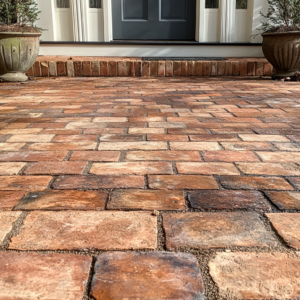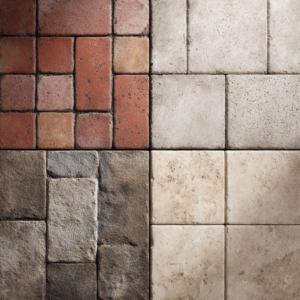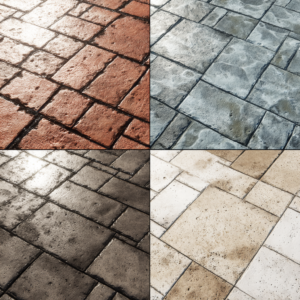When planning your next outdoor project, choosing the right materials is essential to ensure aesthetic appeal and long-lasting durability. One material that has caught some attention in recent years is wood pavers.
But while they might offer a rustic charm, there are a few things to consider before committing to wood for your patio or walkway. So let’s explore some key factors to keep in mind when working with wood pavers for your next hardscape project.
Read also: How to improve your outdoors with decorative pavers
Jump to:
What are wood pavers?

Wood pavers are outdoor flooring materials made from natural wood, typically cut into uniform shapes, such as squares or rectangles, to create a tiled effect when laid out. These pavers are often made from hardwoods like teak, ipe, or cedar, picked for their natural resistance to moisture and decay.
Wood pavers are designed to interlock or fit closely together, much like traditional stone or concrete pavers. They are typically installed over a prepared base, such as sand or gravel, and may require additional supports or grids to prevent shifting over time.
While they offer a unique look that can complement certain landscapes, it’s important to recognize that wood is inherently more vulnerable to environmental factors such as moisture, insects, and fluctuating temperatures.
Wood pavers offer natural beauty and an ability to blend seamlessly with outdoor surroundings. However, this material also presents certain challenges, especially when compared to more durable options like concrete. As a natural product, wood is subject to aging, which can lead to discoloration, splintering, or other forms of deterioration over time.
Characteristics of wood pavers

Low durability
Outdoor spaces are constantly exposed to the elements. From rain and snow to heat and humidity, your hardscape materials need to stand the test of time.
Wood pavers, while attractive at first, may face some challenges in this regard. Wood, as a natural material, is prone to warping, rotting, and insect damage over time, especially in regions with high moisture levels. This can lead to frequent repairs or even a full replacement down the road.
For comparison, let’s think about concrete pavers, which are engineered specifically for outdoor use. They are designed to withstand harsh weather conditions without losing their structural integrity. Unlike wood, concrete doesn’t warp or rot, meaning it will maintain its shape and strength for many years.
Concrete pavers also resist damage from pests, providing peace of mind that your outdoor investment is safe from unwanted intrusions.
Costly maintenance
Maintaining the appearance of your hardscape is another important consideration. Wood pavers, though visually appealing when freshly installed, require frequent upkeep. Regular sealing, staining, or treating is necessary to preserve their appearance and protect them from environmental wear.
Neglecting these maintenance tasks can result in fading, splintering, or worse, making the area unsafe for use. Over time, this can become not only time-consuming but costly as well.
Sustainability
Sustainability is an increasingly significant factor for many homeowners today. While wood is often marketed as a natural and sustainable material, it’s important to remember that most wood pavers require chemical treatments to resist decay and insects.

These treatments can sometimes include harmful substances, making the pavers less eco-friendly than they might appear. Additionally, deforestation concerns come into play when sourcing wood for large projects.
Besides, since wood pavers need to be replaced more frequently, they end up producing more waste, since the wood cannot be recycled due to the chemicals used to treat it.
You may also like: Creative leftover paver ideas – don’t let them go to waste!
Customization
When it comes to design flexibility, wood pavers don’t offer a wide range of options. They are often limited in shape and size due to the nature of the material, meaning your design options may be somewhat restricted.
Cost considerations
Budget is always a major factor when choosing materials for any project. While wood pavers can sometimes be less expensive upfront, the long-term costs can add up quickly due to the need for frequent maintenance, repairs, and eventual replacement.
So… wood pavers. Not really the best idea.

So, at the end of the day, while wood pavers offer a unique, natural appeal, the reality is that they come with certain drawbacks that may not make them the best choice for a long-lasting, low-maintenance hardscape.
Every other paver option – like concrete, brick, and natural stone – provides much more durability, minimal upkeep, and versatile design options, making them a superior choice for most outdoor spaces.
For homeowners looking to invest in a hardscape project that looks great and stands the test of time, these other options are proven to be vastly superior to wood in the long run.
Still, before making any final decisions, it is always a good idea to ask for the help of a professional hardscape contractor. So look for one you can trust around your area. And if you happen to be around Sarasota County, FL, we here at JS Brick would be glad to put our 24 years of experience at your service. So in get in contact right now for a free estimate on our services.



